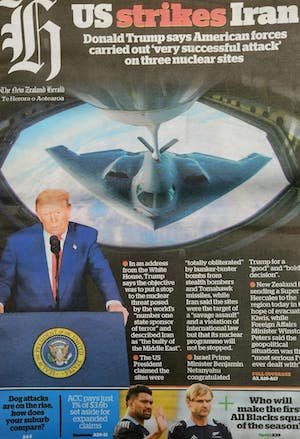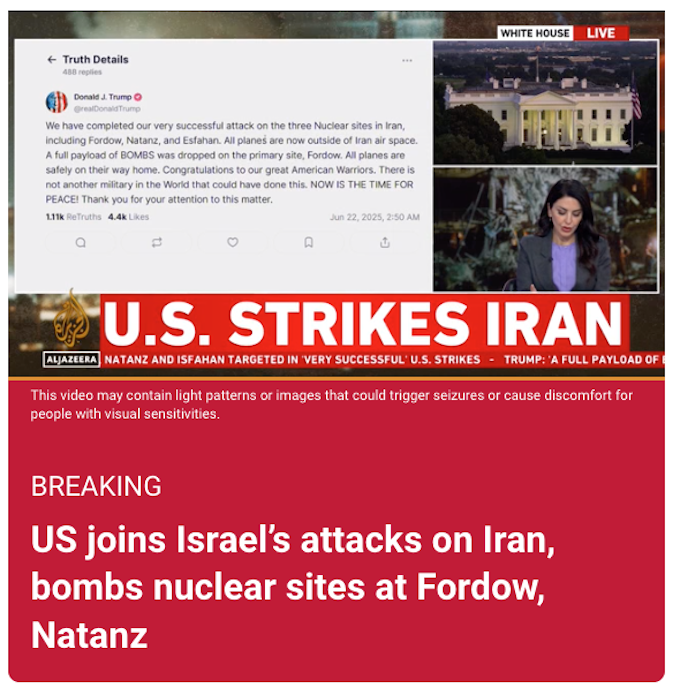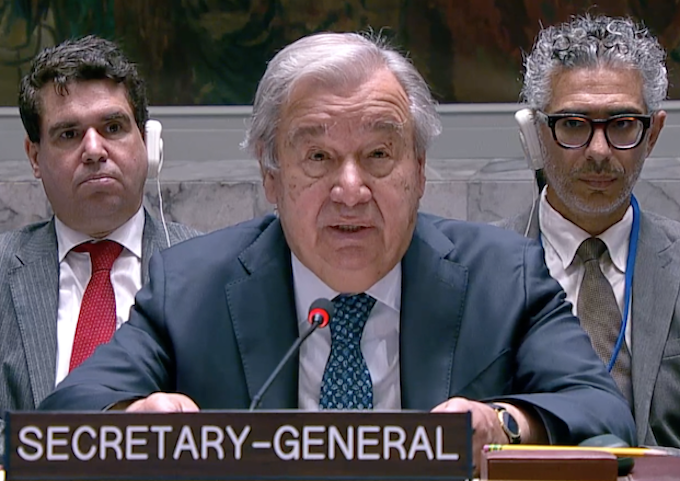This post was originally published on Dissident Voice.
Over an effing billion of these Goy-ionists?
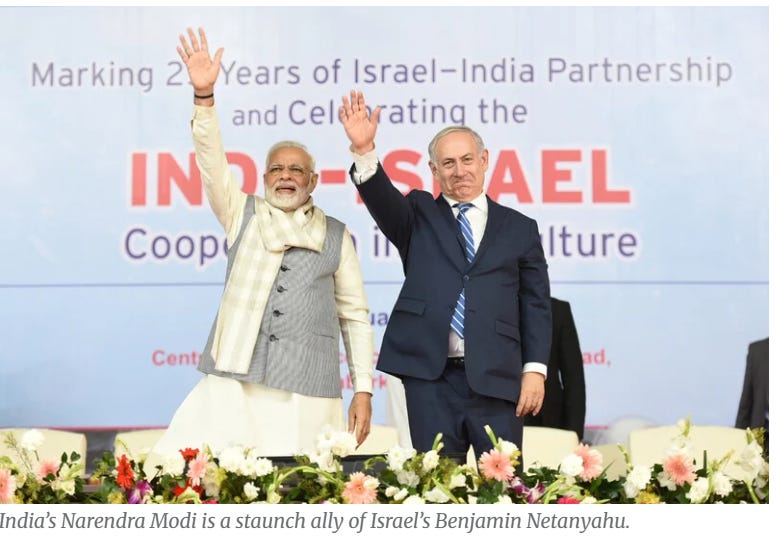
Days later, India launched Operation Sindoor, a wave of air strikes, describing them as “non-escalatory” in nature. Yes, that is the face of Judaism in that part of the world, where Benzion Mileikowsky works wonders on the Jewish Population where 84 percent plus want all Palestinians wiped from lower Greater Israel.
Many of the drones used in the operation were Israeli-made.
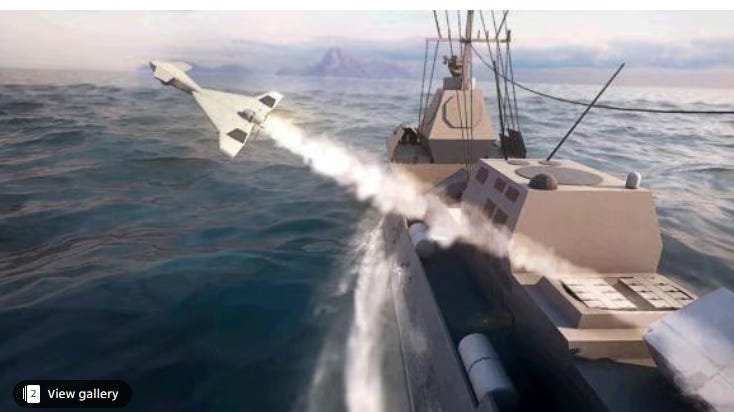
Among the systems deployed was the Harop, a “suicide drone” developed by Israel Aerospace Industries (IAI). Designed to hover above a target area before diving for impact, the Harop carries a 10-kilogram warhead and can remain airborne for nearly six hours.
Since acquiring the Harop, India has increasingly relied on it.
Oshrit Birvadker, a fellow at the Jerusalem Institute for Strategy and Security, told The Times of Israel that India’s use of Harop drones reflects “Israel’s growing footprint in Indian defense.”

That’s fourth globally in arms sales, Jewish State of Murdering Maiming Raping Starving Poisoning Polluting Displacing Israel (sic).
Marching to get into the Katz’s and Benzion Mileikowsky’s heads? For fuck’s sake!
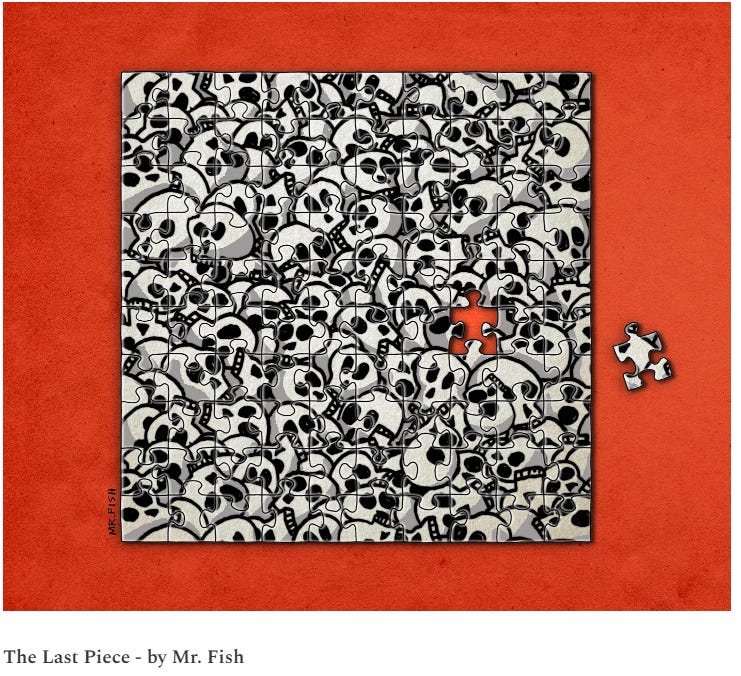
Chris Hedges: This is the end. The final blood-soaked chapter of the genocide. It will be over soon. Weeks. At most. Two million people are camped out amongst the rubble or in the open air. Dozens are killed and wounded daily from Israeli shells, missiles, drones, bombs and bullets. They lack clean water, medicine and food. They have reached a point of collapse. Sick. Injured. Terrified. Humiliated. Abandoned. Destitute. Starving. Hopeless.
In the last pages of this horror story, Israel is sadistically baiting starving Palestinians with promises of food, luring them to the narrow and congested nine-mile ribbon of land that borders Egypt. Israel and its cynically named Gaza Humanitarian Foundation (GHF), allegedly funded by Israel’s Ministry of Defense and the Mossad, is weaponizing starvation. It is enticing Palestinians to southern Gaza the way the Nazis enticed starving Jews in the Warsaw Ghetto to board trains to the death camps. The goal is not to feed the Palestinians. No one seriously argues there is enough food or aid hubs. The goal is to cram Palestinians into heavily guarded compounds and deport them.
Some bulwarks across international community would stop this. Fuck, it is a Jewish project across all DNA-lines.
Given Britain’s continued support for Israel, from refusing to implement a full arms embargo to continuing to send RAF spy flights over Gaza from the British base at RAF Akrotiri in Cyprus, Ahmed questions whether efforts have indeed been enough.
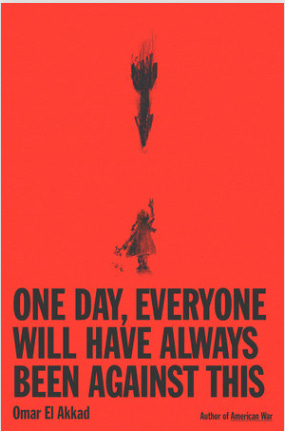
Israeli drones sprayed the Madleen with a white substance and an Israeli boat rammed the aid vessel before commandos boarded it, all because it contained things like baby food, medicine and prosthetics. Israel must defend itself from those things, apparently.

Is this a certain brand of Jewish Inspired, Supported, Financed death and murder cult? Is the question antisemitic?

Dirty dirty Sweden:

The Temporary Protection Directive (2001/55/EC) (commonly referred to as collective temporary protection) was activated in March 2022, granting Ukrainians seeking refuge temporary protection in EU countries, including Sweden. This directive provides residence permits, access to work, education, and limited social benefits without requiring individuals to go through the standard asylum process.
However, the practicalities of the Directive’s use differed significantly between countries. Sweden, despite its, until recent, reputation of being relatively liberal in its migration policies, has at times, lagged behind its Scandinavian neighbors in supporting Ukrainian displaced people. To illustrate this, it is useful to compare the Swedish approach to that of other Nordic states, as well as Poland.

Bizarrely, Israel’s act of piracy was described by the BBC as “diverting” the Madleen. In what universe was this a diversion? When you capture people in international waters who have committed no crime, you have not diverted them, you have kidnapped them. The crew of the Madleen are hostages, and not only that, Israel is already bragging about how it plans to abuse them.
The crew of 12, who the media describe as “activists”, comprised of journalists, politicians, and a doctor. They are to be taken to the port of Ashdod where they will be psychologically tortured by the IDF/IOF.
Israel Katz says he has given the order to make the crew watch footage of October 7th to show them “exactly who the terrorist organization they came to support and for whom they work is”. Presumably, they will only watch the killings carried out by Hamas and not the enactment of the Hannibal Directive killing hundreds of Jews by Jews.

Pointing out the non-Jews and Jews involved, is that antisemitic?

Remember this Jewish guy?
1992 document published by the US Department of Defense, known as the Wolfowitz Doctrine (because it was co-written by Paul Wolfowitz, who then served as US undersecretary of defense for policy, before later returning as Secretary of Defense under George W. Bush).
The Pentagon’s Wolfowitz Doctrine stated (emphasis added):
Our first objective is to prevent the re-emergence of a new rival. This is a dominant consideration underlying the new regional defense strategy and requires that we endeavor to prevent any hostile power from dominating a region whose resources would, under consolidated control, be sufficient to generate global power. These regions include Western Europe, East Asia, the territory of the former Soviet Union, and Southwest Asia.
The Trump administration’s foreign policy is still consistent with much of the Wolfowitz Doctrine. Although Trump has de-prioritized Western Europe and the territory of the former USSR, he has dedicated significant resources to US military operations in East Asia and Southwest Asia (also known as the Middle East).
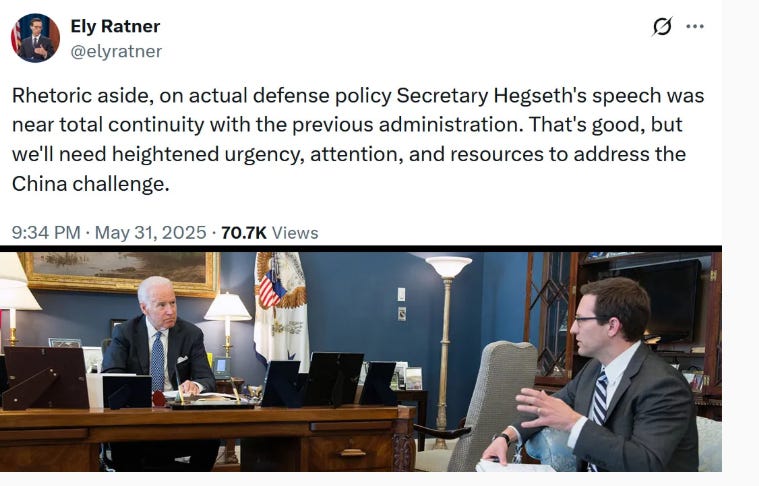
Yep, even CIA-drenched Wikipedia advances Ratner’s Judaism:
Ely Ratner, who served as the assistant secretary of defense for Indo-Pacific security affairs in Biden’s Pentagon, wrote approvingly on X/Twitter, “Rhetoric aside, on actual defense policy Secretary Hegseth’s speech was near total continuity with the previous administration”.
“That’s good, but we’ll need heightened urgency, attention, and resources to address the China challenge”, Ratner added.
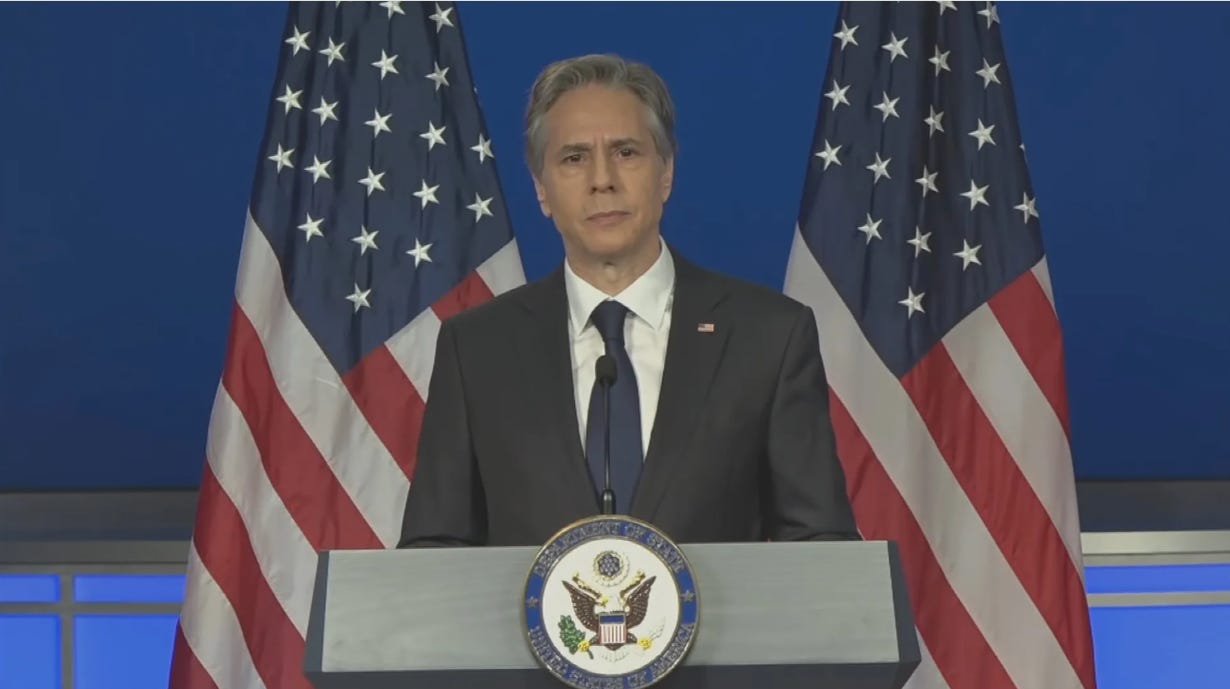
This fellow for years advanced his Jewishness for sure Zyklon or Final Solution Blinken:
Biden’s neoconservative Secretary of State Antony Blinken had also maintained a hardline anti-China position.
In a speech in 2022, Blinken announced what was essentially a containment policy targeting China.
“We cannot rely on Beijing to change its trajectory. So we will shape the strategic environment around Beijing”, he said.
Blinken added, “The scale and the scope of the challenge posed by the People’s Republic of China will test American diplomacy like nothing we’ve seen before”.
Tucker Carlson has posted an extraordinary article on X that could potentially stop a war with Iran. As everyone knows, Carlson’s political views are admired by President Donald Trump who sees the former Fox commentator as a blunt, but fair-minded analyst who sees the world in similar terms as himself. And while there’s no evidence that the two men communicate regularly, a number of pundits believe that Carlson has influenced Trump’s thinking, particularly on matters related to foreign policy. That said, it is entirely possible that Trump will read Carlson’s June 4 post on Iran, and see that—once again—influential neocons are making every effort to drag the US into another bloody conflict in the Middle East to achieve Israel’s ambition of becoming the preeminent power in the region. Here’s Carlson:
Mark Levin was at the White House today, lobbying for war with Iran. To be clear, Levin has no plans to fight in this or any other war. He’s demanding that American troops do it. We need to stop Iran from building nuclear weapons, he and like-minded ideologues in Washington are now arguing. They’re just weeks away.
If this sounds familiar, it’s because the same people have been making the same claim since at least the 1990s. It’s a lie. In fact, there is zero credible intelligence that suggests Iran is anywhere near building a bomb or has plans to. None. Anyone who claims otherwise is ignorant or dishonest. If the US government knew Iran was weeks from possessing a nuclear weapon, we’d be at war already.
Iran knows this, which is why they aren’t building one. Iran also knows it’s unwise to give up its weapons program entirely. Muammar Gaddafi tried that and wound up sodomized with a bayonet. As soon as Gaddafi disarmed, NATO killed him. Iran’s leaders saw that happen. They learned the obvious lesson.
So why is Mark Levin once again hyperventilating about weapons of mass destruction? To distract you from the real goal, which is regime change — young Americans heading back to the Middle East to topple yet another government. Virtually no one will say this out loud. America’s record of overthrowing foreign leaders is so embarrassingly counterproductive that regime change has become a synonym for disaster. Officially, no one supports it. So instead of telling the truth about their motives, they manufacture hysteria: “A country like Iran can never have the bomb! They’ll nuke Los Angeles! We have to act now!” Tucker Carlson (tuckercarlsonliveshowpodcast)
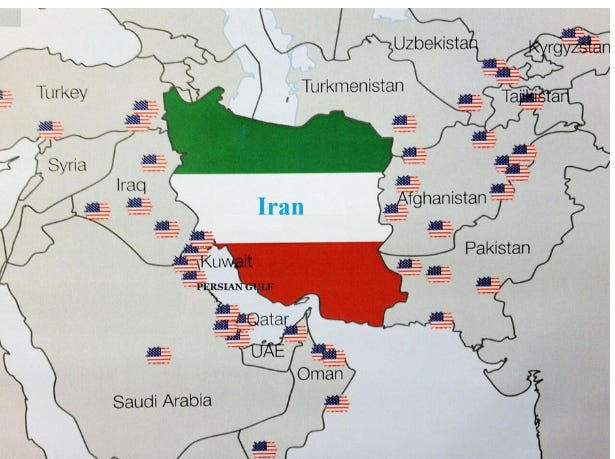
*****
Back to the death spiral of the Jewish Controlled Palestine:
In his book One Day, Everyone Will Have Always Been Against This, Omar El Akkad writes:
Should a drone vaporize some nameless soul on the other side of the planet, who among us wants to make a fuss? What if it turns out they were a terrorist? What if the default accusation proves true, and we by implication be labeled terrorist sympathizers, ostracized, yelled at? It is generally the case that people are most zealously motivated by the worst plausible thing that could happen to them. For some, the worst plausible thing might be the ending of their bloodline in a missile strike. Their entire lives turned to rubble and all of it preemptively justified in the name of fighting terrorists who are terrorists by default on account of having been killed. For others, the worst plausible thing is being yelled at.
You can see his interview with El Akkad here.
You cannot decimate a people, carry out saturation bombing over 20 months to obliterate their homes, villages and cities, massacre tens of thousands of innocent people, set up a siege to ensure mass starvation, drive them from land where they have lived for centuries and not expect blowback. The genocide will end. The response to the reign of state terror will begin. If you think it won’t you know nothing about human nature or history. The killing of two Israeli diplomats in Washington and the attack against supporters of Israel at a protest in Boulder, Colorado, are only the start.
Chaim Engel, who took part in the uprising at the Nazis’ Sobibor death camp in Poland, described how, armed with a knife, he attacked a guard in the camp.
“It’s not a decision,” Engel explained years later. “You just react, instinctively you react to that, and I figured, ‘Let us to do, and go and do it.’ And I went. I went with the man in the office and we killed this German. With every jab, I said, ‘That is for my father, for my mother, for all these people, all the Jews you killed.’”
Does anyone expect Palestinians to act differently? How are they to react when Europe and the United States, who hold themselves up as the vanguards of civilization, backed a genocide that butchered their parents, their children, their communities, occupied their land and blasted their cities and homes into rubble? How can they not hate those who did this to them?
What message has this genocide imparted not only to Palestinians, but to all in the Global South?
It is unequivocal. You do not matter. Humanitarian law does not apply to you. We do not care about your suffering, the murder of your children. You are vermin. You are worthless. You deserve to be killed, starved and dispossessed. You should be erased from the face of the earth.
“To preserve the values of the civilized world, it is necessary to set fire to a library,” El Akkad writes:
To blow up a mosque. To incinerate olive trees. To dress up in the lingerie of women who fled and then take pictures. To level universities. To loot jewelry, art, food. Banks. To arrest children for picking vegetables. To shoot children for throwing stones. To parade the captured in their underwear. To break a man’s teeth and shove a toilet brush in his mouth. To let combat dogs loose on a man with Down syndrome and then leave him to die. Otherwise, the uncivilized world might win.
There are people I have known for years who I will never speak to again. They know what is happening. Who does not know? They will not risk alienating their colleagues, being smeared as an antisemite, jeopardizing their status, being reprimanded or losing their jobs. They do not risk death, the way Palestinians do. They risk tarnishing the pathetic monuments of status and wealth they spent their lives constructing. Idols. They bow down before these idols. They worship these idols. They are enslaved by them.
At the feet of these idols lie tens of thousands of murdered Palestinians.
This post was originally published on Dissident Voice.
By Susana Suisuiki, Presenter/producer of RNZ Pacific Waves
Fiji’s Embassy in Abu Dhabi says it is closely monitoring the situation in Iran and Israel as tensions remain high.
Israel carried out a dozen strikes against Iranian military and nuclear sites on Friday, claiming it acted out of “self-defence”, saying Iran is close to building a nuclear weapon.
Iran’s Supreme Leader Ayatollah Ali Khamenei warned Israel that “severe punishment” would follow and two waves of missiles were fired at Israel.
Fiji’s Embassy in Abu Dhabi is urging the Fijian community there to remain calm, stay informed, and reach out to the Embassy should they have any concerns or require assistance during this period of heightened regional tensions.
A Fiji national in Abu Dhabi said he had yet to hear how other Pacific communities in the Middle East were coping amid the Israel-Iran conflict.
Speaking to RNZ Pacific Waves from Abu Dhabi, Fiji media specialist Kelepi Abariga said the situation was “freaky and risky”.
Abariga has lived in Abu Dhabi for more than a decade and while he was far from the danger zones, he was concerned for his “fellow Pacific people”.
‘I hope they are safe’
“I just hope they are safe as of now, this is probably the first time Israel has attacked Iran directly,” he said.
“Everybody thinks that Iran has a huge nuclear deposit with them, that they could use it against any country in the world.
“But you know, that is yet to be seen.
“So right now, you know we from the Pacific, we’re right in the middle of everything and I think you know, our safety is paramount.”
Abariga was not aware of any Pacific people in Tehran but said if they were, they were most likely to be working for an NGO or the United Nations.
However, Abariga said there were Fiji nationals working at the International Christian embassy in Jerusalem and Solomon Island students in the south of Israel.
He also said that Fijian troops were stationed at Golan Heights occupied by Israel.
While Abariga described Abu Dhabi as the safest country in the Middle East, he said the politics in the region were volatile.
“It’s been intense like that for all this time, and I think when you mention Iran in this country [UAE], they have all the differences so it’s probably something that has started a long way before.”
This article is republished under a community partnership agreement with RNZ.
This post was originally published on Asia Pacific Report.

A short guide on how to engineer a genocide by starvation and ethnic cleansing:
1. Choose your moment. Ok, you’ve been ethnically cleansing, occupying, oppressing, and killing your neighbours for decades. The international courts have ruled your actions illegal. But none of that will matter the moment your neighbours retaliate by attacking you. Don’t worry. The Western media can be relied on to help out here. They will be only too ready to pretend that history began on the day you were attacked.
2. Declare, in response, your intention to starve your neighbours, treating them as “human animals”, by blocking all food, water, and power. You will be surprised by how many Western politicians are ready to support this as your “right to defend yourself”. The media will echo them. It is important not to just talk about blocking aid. You must actually do it. There will be no serious pushback for many, many months.
3. Start relatively slowly. Time is on your side. Let a little bit of aid in. But be sure to relentlessly smear the well-functioning, decades-old aid distribution system run by the international community, one that is transparent, accountable, and widely integrated into the communities it serves. Say it is infiltrated by “terrorists”.
4. Use that claim – evidence isn’t really necessary, the western media never ask for it – as the pretext to bomb the aid system’s warehouses, distribution centres, and community kitchens. Oh, and don’t forget to bomb all the private bakeries, destroy all the farmland, shoot all the animals, and kill anyone who tries to use a fishing boat, so that there are no other sources of food. You are now in control of the trickle of aid reaching what is rapidly becoming a severely malnourished population.
5. Time to move into higher gear. Stop the international community’s aid from getting in altogether. You will need a humanitarian cover story for this bit. The danger, particularly in an age of social media, is that images of starving babies will make you look very bad. Hold firm. You can get through this. Claim – again, evidence isn’t really necessary, the western media won’t ask for it – that the “terrorists” are stealing the aid. You will be surprised how willing the media is to talk about babies going “hungry”, ignoring the fact that you are starving them to death, or speak of a “famine”, as though from drought and crop failure, not from your carefully laid plans.
6. Don’t lose sight of the bigger story. You are blocking aid to “eradicate the terrorists”. After all, what is the worth of a baby, of a child – all one million of them – in the fight to eliminate a rag-tag army of lightly armed “terrorists” who have never waged their struggle outside of their historic homeland?
7. Now that the population is entirely at your disposal, you can roll out a “humanitarian” alternative to the existing system you have been vilifying and wrecking. Probably best to have been working on this part of the plan behind the scenes from early on, and to have regularly consulted with the Americans on how to develop it. You may even find they are willing to fund it. They usually are. You can obscure their role by using the term “private contractors”.
8. It’s time for implementation. Obviously, the point is not to really distribute aid. It is all about providing a cover story so that the starvation and ethnic cleansing can continue. Ensure that you provide only a tiny amount of aid and make it available only at a few distribution points you have set up with these “private contractors”. This has two advantages.
9. It forces the population to come to the areas you want them in, like luring mice into a trap. Get them to the very edge of the territory, because from there you will be best positioned at some point to drive them over the border and get rid of them for good.
10. Your system will lead to chaos, as desperate, starving people fight for food. That’s great for you. It makes them look like a swarming mass of those “human animals” you were talking about from the start. Don’t they deserve their fate? And it means that young, fit men – especially those from large, often armed, criminal families – will end up with most of the food. The stuff they can’t grab at the distribution points, they will ambush later as people try to return home laden with their heavy aid packages. That may seem counter-productive, given that you’re claiming to want to eliminate the “terrorists”. Won’t these fit, young men, as conditions degenerate further, provide a future source of recruits to the “terrorists”? But remember, the real goal here is to starve the population as quickly as possible. The young, the elderly, the sick, and the vulnerable are the ones who will die first. The more of them who start dying, the faster the pressure builds on everyone else to flee the territory to save themselves.
You are nearly there. True, faced with the emaciated bodies of your victims, Western politicians will start making harsh pronouncements. But they have already given you a massive head start of 20 months. Be grateful for that. You don’t need much longer. While they dither, you can get on with the job of extermination. Leave it to the history books to judge what really happened.
The post A Short Guide on How to Starve a Population to Death first appeared on Dissident Voice.This post was originally published on Dissident Voice.
Last Thursday, May 22, a coalition named Veterans and Allies Fast for Gaza kicked off a 40-day fast outside the United Nations in Manhattan in protest against the U.S.-backed Israeli genocide in Gaza. Military veterans and allies pledged to fast for 40 days on only 250 calories per day, the amount recently reported as what the residents of Gaza are enduring.
The fasters are demanding:
1) Full humanitarian aid to Gaza under UN authority, and
2) No more U.S. weapons to Israel.
Seven people are fasting from May 22 to June 30 outside the U.S. Mission to the United Nations, where they are present from 9:30 a.m. to 3 p.m., Mondays through Fridays. Many others are fasting around the U.S. and beyond for as many days as they can. The fast is organized by Veterans For Peace along with over 40 co-sponsoring organizations.
Remarkably, over 600 people have registered to join the fast. Friends of Sabeel, NA, is maintaining the list of fasters.
Who will stop the genocide in Palestine, if not us? That is the question that the fasters and many others are asking. The U.S. government is shamelessly complicit in Israel’s genocide, and to a lesser extent, the same is true for the European governments. The silence and inaction of most Middle Eastern countries is resounding. Lebanon, Yemen, and Iran, the only countries to come to Palestine’s aid, have been bombed by Israel and the U.S., with the threat of more to come. Syria, another country that stood with Palestine, has been “regime changed” and handed over to former al-Qaeda/ISIS extremists.
On the positive side, some governments are making their voices heard. South Africa and Nicaragua have taken Israel and Germany, respectively, to the International Court of Justice – Israel for its genocide, and Germany for providing weapons to Israel. And millions of regular people around the globe have protested loudly and continue to do so.
Here in the United States, Jewish Voice for Peace has provided crucial leadership, pushing back against the phony charges of “anti-semitism” that are thrown at the student protesters whose courageous resistance has spoken for so many. University administrators have been all too quick to crack down on the students, violating their right to freedom of speech, but even these universities have come under attack from the repressive, anti-democratic Trump administration.
Peace-loving people are frustrated and angry. Some are worried they will be detained or deported. And many of us are suffering from Moral Injury, concerned about our own complicity. How are we supposed to act as we watch U.S. bombs obliterate Gaza’s hospitals, mosques, churches, and universities? What are we supposed to do when we see Palestinian children being starved to death, systematically and live-streamed?
Because our movement is nonviolent, we do not want to follow the example of the young man who shot and killed two employees of the Israeli Embassy in Washington, DC. However, we understand his frustration and the driving force behind his forceful action. We take courage from the supreme sacrifice of U.S. Airman Aaron Bushnell, who self-immolated in front of the Israeli Embassy, asking, “What would you do?”
Student protesters at several universities around the country have initiated “hunger strikes,” a protest tactic often considered a last resort. Now they have been joined by military veterans.
“Watching hundreds of people maimed, burned, and killed every day just tears at my insides,” said Mike Ferner, former Executive Director of Veterans For Peace and one of the fasters. “Too much like when I nursed hundreds of wounded from our war in Vietnam,” said the former Navy corpsman. “This madness will only stop when enough Americans demand it stops.”
Rev. Addie Domske, National Field Organizer for Friends of Sabeel North America (FOSNA), said, “This month I celebrated my third Mother’s Day with a renewed commitment to parent my kid toward a free Palestine. As a mother, I am responsible for feeding my child. I also believe, as a mother, I must be responsive when other children are starving.
Kathy Kelly, board president of World BEYOND War, also in NY for the fast, said, “Irish Nobel laureate Mairead Maguire, at age 81, recently fasted for forty days, saying ‘As the children of Gaza are hungry and injured with bombs by official Israeli policy, I have decided that I, too, must go hungry with them, as I in good conscience can do no other.’ Now, Israel intensifies its efforts to eradicate Gaza through bombing, forcible displacement, and siege. We must follow Mairead’s lead, hungering acutely for an end to all weapon shipments to Israel. We must ask, ‘who are the criminals?’ as war crimes multiply and political leaders fail to stop them.”
Another faster is Joy Metzler: 23, Cocoa, FL., a 2023 graduate of the Air Force Academy who became a Conscientious Objector and left the Air Force, citing US aggression in the Middle East and the continued ethnic cleansing in all of Palestine. Joy is now a member of Veterans For Peace and a co-founder of Servicemembers For Ceasefire.
“I am watching as our government unconditionally supports the very violations of international law that the Air Force trained me to recognize,” said Joy Metzler. “I was trained to uphold the values of justice, and that is why I am speaking out and condemning our government’s complicity in the ethnic cleansing of Palestine.”
I spoke with VFP leader Mike Ferner on Day 7 of his Fast. The NYPD had just told him and the other fasters that they could no longer sit down in front of the US Mission to the UN on the little stools they had brought. But Mike Ferner was not complaining. He said:
“We go home every night to a safe bed, and we can drink clean water. We are not watching our children starve to death before us. Our sacrifice is a small one. We are taking a stand for humanity, and we encourage others to do what they can. Demand full humanitarian relief in Gaza under UN authority, and an end to U.S. weapons shipments to Israel. This is how we can stop the genocide.”
More information about how you can participate or support the fasters is available at
Veterans and Allies Fast for Gaza.
To arrange interviews with the fasters, contact Mike Ferner at 314-940-2316.
The post Why Are Veterans and Allies Fasting for Gaza? first appeared on Dissident Voice.This post was originally published on Dissident Voice.
“Removing a dictator is not enough; real change requires a shift in governance, security, justice.”

Syrians gather in celebration days after the fall of Bashar Assad’s government at Umayyad Square in Damascus on Dec. 12, 2024. | Leo Correa/AP
On 19 May 2025 Bassam Alahmad, Noah Abbas, and Simav Hasan wrote in Global Citizen an interesting piece on how Syrian human rights defenders feel about the changes in their country:
In a previously published Global Citizen In My Own Words article, human rights defender Bassam Alahmad detailed his experiences of being a stateless citizen residing in Syria who stands for justice. In this article, following the fall of Al-Assad, Bassam Alahmad is joined by colleagues from Syrians For Truth and Justice, Simav Hasan, and Noah Abbas, as they share their reflections on what the regime change in the country means for them personally and for their hopes for a democratic Syria.
How would you describe your relationship with Syria and how has the decades-long conflict impacted you?
Bassam Alahmad: I think ‘complicated’ or ‘complex’ is the best way to describe my relationship with Syria. Being born stateless means having no rights, but we love our country because we were born there. We know the people and communities and we belong to the land but I didn’t feel as though I belonged politically. I didn’t feel as though I had full citizenship in the country. I like my country but unfortunately, the way in which the Kurdish people were treated for decades made it so we didn’t feel like we were equal parts of this country.
Noah Abbas: As a Kurdish Syrian national, the long-standing conflict in Syria has profoundly influenced both my personal and professional life. It has not only shaped my views on war and peace, but has also deepened my understanding of resilience and the value of community. Witnessing the enduring struggles of friends, family, and the broader Syrian community has motivated me to advocate for humanitarian causes and pursue solutions that aim to bring lasting peace to the region. The impact of this conflict extends into my academic pursuits as well; I am currently engaged in postgraduate studies in military intelligence and security.
This academic path was chosen with a clear purpose: to shift the perspective on the role of intelligence in Syria. Under Al-Assad’s governance, intelligence agencies were often viewed as instruments of fear, particularly against opponents of the regime. As a human rights activist, I believe it is our duty to transform this perception and demonstrate how intelligence can serve as a cornerstone for justice and societal safety. Joining the efforts of Syrians for Truth and Justice has been crucial in my journey.
Simav Hasan: I am a Kurd from Qamishli, and so my existence here has always been shaped by layers of oppression, resistance, and hope. The decades-long conflict has left scars on my community and on me personally. I’ve witnessed forced displacement, the suffering of victims, and the destruction of lives and history. But more than that, I’ve felt the weight of injustice firsthand — whether through the fight for accountability, the struggle for basic rights, or the ongoing humanitarian crises. Despite everything, I refuse to detach myself from this reality. My work as a journalist and human rights activist is my way of pushing back against the violence, ensuring that the voices of the victims are heard, and trying to carve out a future where justice isn’t just a distant dream. The war has taken much, but it has also strengthened my resolve. Even in the darkest moments, I believe in the power of truth, memory, and resistance.
………
In 2024 the Al-Assad government fell, how did this make you feel?
Alahmad: To be honest, while part of me is very happy that there is no longer the Assad regime, part of me also thinks that there is a big obstacle in the road to democracy, open civic society, and citizenship. As people working in human rights we must not be naive because we know the history and we know that there are human rights violations committed. The main issue is there is a huge gap betweenwhat they say to the west — to the EU, to the US, to the UN — and what they ultimately decide. For example, the national dialogue was kind of a missed opportunity, where instead of having a good version of national dialogue in Damascus and to be more inclusive, they excluded a huge part of Syria, including Kurds and other minorities.
It was a missed opportunity. The same is true with the constitutional declaration adopted in March 2025. They didn’t recognize the Kurdish people or the Kurdish language. They did not recognize diversity. Most of the authority was in the hands of the president. Our main problem is that Syria without the Assad regime is good, but there is no guarantee that we are going towards democracy. The recent Human Rights Watch report on the constitutional declaration clearly states that this constitutional declaration is not a road to a democratic country. This should be very clear for our partners in the US, the EU, and the international community. The most serious thing that happened in the coastal area in Latakia and Tartus is that hundreds of Alawite people were killed based on their identity, because they are from this minority group. A lot of violations happened by the groups linked to the government.
Abbas: The fall of the Al-Assad government, as welcomed by human rights organizations, provoked a complex mix of emotions within me. On one hand, I felt a profound sense of relief and happiness that the brutal regime, known for its relentless human rights violations and oppressive rule, had come to an end. The release of prisoners of conscience and the acknowledgment of the sacrifices made by countless human rights defenders brought a wave of hope for a future where justice and accountability could finally be addressed. However, as a Kurdish-Syrian national, this transition also brought with it significant fears and concerns. The potential for ethnic conflicts or even ethnic cleansing within the new power structures (such as the factions that committed violations in Efrin city, my home town, and other Kurdish cities across the country) was alarming, especially given the historical challenges faced by Kurdish communities in asserting their rights and safety within Syria.
Despite these fears, the fall of the regime marked a critical moment for Syria — an opportunity to rebuild and redefine the nation on the principles of freedom, justice, and human dignity. It was a moment to champion the efforts of Syrians for Truth and Justice and engage more actively in the civil society space dedicated to transitional justice and documenting human rights violations.
Hasan: With the fall of the Assad government, I felt a sense of cautious optimism. It marked the end of a regime responsible for decades of repression, war crimes, and mass atrocities — a moment many victims and survivors had long awaited. There was hope that this could be the beginning of rebuilding Syria on principles of justice, accountability, and human rights. However, I remained wary. The fall of a regime does not automatically guarantee freedom or stability. Power vacuums in Syria have often led to new forms of repression and external interference. Many armed actors still operate with impunity, and the path to true justice remains uncertain. While this moment was significant, real change depended on what came next. Would justice be pursued? Would the voices of victims and marginalized communities — especially Kurds and other oppressed groups — be heard? The fall of Assad was a turning point, but Syria’s future was still being written.
https://www.globalcitizen.org/en/content/syria-justice-human-rights-after-al-assad/
This post was originally published on Hans Thoolen on Human Rights Defenders and their awards.
“Sumūd, the process of steadfastness, of survivance, is not just a project of survival, but also one of remembrance, record-keeping, and revitalization,” write Malu Halasa and Jordan Elgrably in the introduction to Sumūd: A New Palestinian Reader (Seven Stories Press). The world has now witnessed sumūd at its most tenacious, as Palestinians hold on to life, dignity and a centuries-old culture…
This post was originally published on Latest – Truthout.
Early in life, I learned of the deliberate manner by which Zionists confuse the public and frame the Middle East conflicts to favor them. Commentators have gone to great length to explain the “special relationship” between Israel and the United States, treating it as a unique affair, in which both benefit. This slogan is a hoax, which originated during World War II as a description of the relationship between embattled Great Britain and a still neutral United States. Somehow and somewhere, a clever someone adapted the World War II slogan to Israel and managed to insert the relationship into the everyday activities of several western nations.
I witnessed Israeli immigrants inviting fellow workers to their homes and lecturing them on why they should support Israel. I know of them going to synagogues and urging the Rabbis to place the Israeli flag next to the American flag, which is now de rigeur. Contracts are given to Israeli organizations and company secrets are funneled to Israeli organizations.
In public schools, efforts are made to gain support for Israel by emphasis on the World War II Holocaust (nothing on the Nakba), and with events organized to attack Israel’s adversaries. I saw students brought to a school library for them to choose general biographies to read, seven out of ten were of personalities from the World War II Holocaust. One librarian, and behaving nervously, showed her ignorance of the topic by referring to Swedish diplomat Raoul Wallenberg as a Nazi officer who helped the Jews. The World War II Holocaust has a vital place in history, but treating it as a purposeful commodity demeans the lost lives. The Free Darfur movement, accused of alliance with Israeli interests due to Israel’s enmity toward Sudan at that time, organized public school demonstrations against Sudan for purported genocide. Local synagogues advertised the action.
I knew of everyday U.S. citizens acting as research centers for Israel, accumulating social, political and economic statistics on American industrial and commercial life and sending it to Israel ─ unregistered foreign agents whose activities are illegal. Students and visiting professors from Israel arrive with more concerns than learning. I have noticed them at university conferences countering Palestinian expressions of grievances with statements such as, “The West Bank roads that Israel is building are meant to serve Palestinians one day,” and then congregate after the meeting to discuss what they can do to counter the remarks made at the meeting. A visiting professor to St. Cloud State University in Minnesota, who was denied using his grant to teach Holocaust studies, sued the university for anti-Semitism and won his case. St. Cloud now has a Jewish Studies and Resources Center but no courses, only a document center.
Georgetown, and many other universities, has a Center for Jewish Civilization (what is Jewish civilization?) that has one principal core course: INAF-1990: Introduction to Jewish Civilization. “This course provides a foundation for the study of Jewish civilization,” which can be taught in five seconds — no known unique contributions to civilization by a Jewish community, maybe by individuals, but not as a community. This Center for Jewish Civilization has periodic meetings, open to the public whose topics have nothing to do with any Jewish civilization and have much to do with Israel ─ real reason for its existence. Most talks are on the World War II Holocaust, Jewish Israel, and the almost non-existent anti-Semitism. No talks on Maimonides and other Jewish philosophers. No talks on past Jewish life in Spain, Tunisia, Iraq, and Europe.
Political, “think tank,” peace, and cultural organizations in Washington, D.C. are unusually populated with Israelis and Israel supporters. One route that I have noticed is where a person obtains credentials from an Israeli institute, is awarded a grant to visit the United states by a sketchy organization, eventually receives an invitation (by a friend) to lecture at a university and becomes recognized as an expert on the Middle East. This leads to a recommendation for a fellowship at a Middle East “think tank,” more recognition, and soon we have an artificially prepared “Middle East expert” who ingratiates with peace groups and tries to steer everyone, including those at the institutions and universities, to lessen aggressive attitudes toward Israel. Nothing too extreme, only a neutralization of activity.
Repetitions of the biblical David and Goliath story, the mythical Exodus, the fictional novel and Hollywood fabricated film called Exodus, and the moribund Kibbutzim presentations, with their Airbnb rental agents posing as sturdy farmers, make it difficult to ascertain if Israel is a country or a public relations stunt. The many organizations that perpetuate the myths and influence parliamentary bodies to favor Israel have no equivalents in the international scene. They have enabled Israel’s oppression and diabolical nature ─ the daily killings of Palestinians, land seizures, and heartless evictions. Number one on the agenda of those who recognize and oppose Israel’s nefarious activities is combating the deception, infiltration, and the global army of pro-Israel groups. This has gained momentum but has not changed the trajectory ─ extermination of the Palestinian people.
Too few know much; too many know little. A coordinated and bludgeoning effort, which shoves the truth into the corner pocket of each person’s billiard mind, which rouses the intellect against those who promote the genocide, and provokes people to act, is a beckoning enterprise. A central source that disburses “talking points,” that distributes knowledge, that provides access to information and rebuttals to disinformation will fill a gap. Knowing where to go and learning what to say are vital factors for combatting the deceptions that Israel’s supporters offer. The Palestinian movement needs committees of correspondence.
The original committees of correspondence “were a collection of American political organizations that sought to coordinate opposition to British Parliament and, later, support for American independence during the American Revolution. The brainchild of Samuel Adams, the committees sought to establish, through the writing of letters, an underground network of communication among Patriot leaders in the Thirteen Colonies.”
Working above ground, in every available space of planet Earth, in every hallway of parliamentary governments, and in every airspace that allows breaths and sounds, a new network of committees of correspondence will distribute reliable and decisive information that answers questions and proves Israel is a criminal activity, is engaged in the genocide of the Palestinian people, engages supporters who are partners to crimes, and bribes legislative supporters who are traitors to their peoples. The organizations will convey specific information and provoke constant talks — in homes, at scheduled meetings, at online forums, in schools, churches, libraries, in every inch of public space. Daily demonstrations and protests throughout the universe will accompany the mass distribution of information.
Too much to chew on for the moment. Part II of this excursion into freeing the world of the Zionist menace will detail the method of organization and the contents of the information. Details will shortly appear.
This post was originally published on Dissident Voice.
Nakba Day today marks 15 May 1948 — the day after the declaration of the State of Israel — when the Palestinian society and homeland was destroyed and more than 750,000 people forced to leave and become refugees. The day is known as the “Palestinian Catastrophe”.
By Soumaya Ghannoushi
US President Donald Trump’s tour of Riyadh, Abu Dhabi and Doha is not diplomacy. It is theatre — staged in gold, fuelled by greed, and underwritten by betrayal.
A US president openly arming a genocide is welcomed with red carpets, handshakes and blank cheques. Trillions are pledged; personal gifts are exchanged. And Gaza continues to burn.
Gulf regimes have power and wealth. They have Trump’s ear. Yet they use none of it — not to halt the slaughter, ease the siege or demand dignity.
- READ MORE: Patients flee Gaza’s Al-Shifa Hospital after Israel forces displacement
- Key takeaways from day two of Donald Trump’s Middle East tour in Qatar
- Other Israel’s war on Gaza reports
In return for their riches and deference, Trump grants Israel bombs and sets it loose upon the region.
This is the real story. At the heart of Trump’s return lies a project he initiated during his first presidency: the erasure of Palestine, the elevation of autocracy, and the redrawing of the Middle East in Israel’s image.
“See this pen? This wonderful pen on my desk is the Middle East, and the top of the pen — that’s Israel. That’s not good,” he once told reporters, lamenting Israel’s size compared to its neighbours.
To Trump, the Middle East is not a region of history or humanity. It is a marketplace, a weapons depot, a geopolitical ATM.
His worldview is forged in evangelical zeal and transactional instinct. In his rhetoric, Arabs are chaos incarnate: irrational, violent, in need of control. Israel alone is framed as civilised, democratic, divinely chosen. That binary is not accidental. It is ideology.
Obedience for survival
Trump calls the region “a rough neighbourhood” — code for endless militarism that casts the people of the Middle East not as lives to protect, but as threats to contain.
His $110 billion arms deal with Saudi Arabia in 2017 was marketed as peace through prosperity. Now, he wants trillions more in Gulf capital. As reported by The New York Times, Trump is demanding that Saudi Arabia invest its entire annual GDP — $1 trillion — into the US economy.
Riyadh has already offered $600 billion. Trump wants it all. Economists call it absurd; Trump calls it a deal.
This is not negotiation. It is tribute.
And the pace is accelerating. After a recent meeting with Trump, the UAE announced a 10-year, $1.4 trillion investment framework with the US.
This is not realpolitik. It is a grotesque spectacle of decadence, delusion and disgrace
Across the Gulf, a race is underway — not to end the genocide in Gaza, but to outspend one another for Trump’s favour, showering him with wealth in return for nothing.
The Gulf is no longer treated as a region. It is a vault. Sovereign wealth funds are the new ballot boxes. Sovereignty — just another asset to be traded.
Trump’s offer is blunt: obedience for survival. For regimes still haunted by the Arab Spring, Western blessing is their last shield. And they will pay any price: wealth, independence, even dignity.
To them, the true threat is not Israel, nor even Iran. It is their own people, restless, yearning, ungovernable.
Democracy is danger; self-determination, the ticking bomb. So they make a pact with the devil.
Doctrine of immunity
That devil brings flags, frameworks, photo ops and deals. The new order demands normalisation with Israel, submission to its supremacy, and silence on Palestine.
Once-defiant slogans are replaced by fintech expos and staged smiles beside Israeli ministers.
In return, Trump offers impunity: political cover and arms. It is a doctrine of immunity, bought with gold and soaked in Arab blood.
They bend. They hand him deals, honours, trillions. They believe submission buys respect. But Trump respects only power — and he makes that clear.
He praises Russian President Vladimir Putin: “Is Putin smart? Yes . . . that’s a hell of a way to negotiate.” He calls Turkish President Recep Tayyip Erdogan “a guy I like [and] respect”. Like them or not, they defend their nations. And Trump, ever the transactional mind, respects power.
Arab rulers offer no such strength. They offer deference, not defiance. They don’t push; they pay.
And Trump mocks them openly. King Salman “might not be there for two weeks without us”, he brags. They give him billions; he demands trillions.
It is not just the US Treasury profiting. Gulf billions do not merely fuel policy; they enrich a family empire. Since returning to office, Trump and his sons have chased deals across the Gulf, cashing in on the loyalty they have cultivated.
A hotel in Dubai, a tower in Jeddah, a golf resort in Qatar, crypto ventures in the US, a private club in Washington for Gulf elites — these are not strategic projects, but rather revenue streams for the Trump family.
Reward for ethnic cleansing
The precedent was set early. Former presidential adviser Jared Kushner, Trump’s son-in-law, secured $2 billion from Saudi Arabia’s sovereign wealth fund shortly after leaving office, despite internal objections.
The message was clear: access to the Trumps has a price, and Gulf rulers are eager to pay.
Now, Trump is receiving a private jet from Qatar’s ruling family — a palace in the sky worth $400 million.
This is not diplomacy. It is plunder.
And how does Trump respond? With insult: “It was a great gesture,” he said of the jet, before adding: “We keep them safe. If it wasn’t for us, they probably wouldn’t exist right now.”
That was his thank you to Saudi Arabia, the UAE and Qatar; lavish gifts answered with debasement.
And what are they rewarding him for? For genocide. For 100,000 tonnes of bombs dropped on Gaza. For backing ethnic cleansing in plain sight. For empowering far-right Israeli politicians, including Finance Minister Bezalel Smotrich and Prime Minister Benjamin Netanyahu, as they call for Gaza’s depopulation.
For presiding over the most fanatically Zionist, most unapologetically Islamophobic administration in US history.
Still, they ask nothing, while offering everything. They could have used their leverage. They did not.
The Yemen precedent proves they can act. Trump halted the bombing under Saudi pressure, to Netanyahu’s visible dismay. When they wanted a deal, they struck one with the Houthis.
And when they sought to bring Syria in from the cold, Trump complied. He agreed to meet former rebel leader turned President Ahmed al-Sharaa — a last-minute addition to his Riyadh schedule — and even spoke of lifting sanctions, once again at Saudi Arabia’s request, to “give them a chance of greatness”.
No US president is beyond pressure. But for Gaza? Silence.
Price of silence
While Trump was being feted in Riyadh, Israel rained American-made bombs on two hospitals in Gaza. In Khan Younis, the European Hospital was reportedly struck by nine bunker-busting bombs, killing more than two dozen people and injuring scores more.
Earlier that day, an air strike on Nasser Hospital killed journalist Hassan Islih as he lay wounded in treatment.
As Trump basked in applause, Israel massacred children in Jabalia, where around 50 Palestinians were killed in just a few hours.
This is the bloody price of Arab silence, buried beneath the roar of applause and the glitter of tributes.
This week marks the anniversary of the Nakba — and here it is again, replayed not through tanks alone, but through Arab complicity.
With every cheque signed, Arab rulers do not secure history’s respect. They seal their place in its sordid footnotes of shame
The bombs fall. The Gaza Strip turns to dust. Two million people endure starvation. UN food is gone.
Hospitals overflow with skeletal infants. Mothers collapse from hunger. Tens of thousands of children are severely malnourished, with more than 3500 on the edge of death.
Meanwhile, Smotrich speaks of “third countries” for Gaza’s people. Netanyahu promises their removal.
And Trump — the man enabling the annihilation? He is not condemned, but celebrated by Arab rulers. They eagerly kiss the hand that sends the bombs, grovel before the architect of their undoing, and drape him in splendour and finery.
While much of the world stands firm — China, Europe, Canada, Mexico, even Greenland – refusing to bow to Trump’s bullying, Arab rulers kneel. They open wallets, bend spines, empty hands — still mistaking humiliation for diplomacy.
They still believe that if they bow low enough, Trump might toss them a bone. Instead, he tosses them a bill.
This is not realpolitik. It is a grotesque spectacle of decadence, delusion and disgrace.
With every cheque signed, every jet offered, every photo op beside the butcher of a people, Arab rulers do not secure history’s respect. They seal their place in its sordid footnotes of shame.
Soumaya Ghannoushi is a British Tunisian writer and expert in Middle East politics. Her journalistic work has appeared in The Guardian, The Independent, Corriere della Sera, aljazeera.net and Al Quds. This article was first published by the Middle East Eye. A selection of her writings may be found at: soumayaghannoushi.com and she tweets @SMGhannoushi.
This post was originally published on Asia Pacific Report.
President Donald Trump announced on Tuesday that he is ordering the “cessation” of U.S. sanctions on Syria, seemingly bringing an end to the U.S.’s decades-long economic suppression of the country as he cozies up to Saudi Arabian leaders. “I will be ordering the cessation of sanctions against Syria in order to give them a chance at greatness,” Trump said in a speech at an investment forum in…
This post was originally published on Latest – Truthout.
It’s been just over 20 years since the Battle of Fallujah, a bloody campaign in a destructive Iraq War that we now know was based on a lie.
But back then, in the wake of 9/11, the battlefield was filled with troops who believed in serving and defending the country against terrorism.
“Going to Fallujah was the most horrific experience of our lives,” said Mike Ergo, a team leader for the US Marines Alpha Company, 1st Battalion. “And it was also, for myself, the most alive I’ve ever felt.”
This week on Reveal, we’re partnering with the nonprofit newsroom The War Horse to join Ergo’s unit as they reunite and try to make sense of what they did and what was done to them. Together, they remember Bradley Faircloth, the 20-year-old lance corporal from their unit who lost his life, and unpack the mental and emotional battles that continue for them today.
This episode originally aired in January 2025.
- Support Reveal’s journalism at Revealnews.org/donatenow
- Subscribe to our weekly newsletter to get the scoop on new episodes at Revealnews.org/newsletter
- Connect with us on Twitter, Facebook and Instagram
This post was originally published on Reveal.



